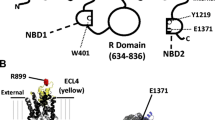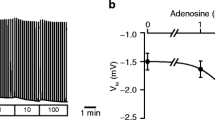Abstract
The permeability properties of the forskolinstimulated Cl− conductance in the apical membrane of Necturus gallbladder epithelium and the possible participation of intracellular Ca2+ in its stimulation have been investigated. The anion selectivity sequence as derived from biionic potential measurements (SCN− > I− ≈ NO −3 > Br− > Cl− ≫ ISE−) differed from the sequence derived from measurements of apical membrane resistance (NO −3 ≈ Br− ≈ Cl− > SCN− > I− ≈ ISE−). Accordingly, the conductance was inhibited by SCN− and I− which, from the potential measurements, appeared to be more permeable than Cl−. This finding agrees with observations of the cystic fibrosis transmembrane conductance regulator (CFTR) Cl− channel reported recently. However, none of the commonly used Cl− channel blockers, such as 5-nitro-2-(3-phenylpropylamino)-benzoic acid (NPPB), 4,4′-diisothiocyanatostilbene-2,2′-disulphonic acid (DIDS), anthracene-9-carboxylic acid (9-AC) and glibenclamide reduced this conductance in Necturus gallbladder. In contrast to the situation in most other epithelia, elevation of intracellular Ca2+ concentration ([Ca2+]i) by ionomycin stimulated only K+ conductance and not that of Cl− in the apical cell membrane. Chelation of intracellular Ca2+ did not prevent the stimulation of Cl− conductance by forskolin. This indicates that [Ca2+]i does not have even a permissive role in the cyclic adenosine monophosphate-(cAMP)-mediated stimulation process, as would have been expected if exocytosis was involved. Further evidence against the involvement of exocytosis in the stimulation process came from the observation that the stimulation was not associated with an increase in apical membrane capacitance and was not suppressed by disruption of the cytoskeleton by preincubation of the tissue with cytochalasin D. The data indicate that Necturus gallbladder epithelium contains homologues of the CFTR Cl− channel which reside permanently in the apical cell membrane and which can be stimulated by a cAMP-dependent phosphorylation process without involvement of cell Ca2+ or exocytosis.
Similar content being viewed by others
References
Allert N, Leipziger J, Greger R (1992) cAMP and Ca2+ act co-operatively on the Cl− conductance of HT29 cells. Pflügers Arch 421:403–405
Anderson MP, Welsh MJ (1991) Calcium and cAMP activate different chloride channels in the apical membrane of normal and cystic fibrosis epithelia. Proc Natl Acad Sci USA 88:6003–6007
Anderson MP, Gregory RJ, Thompson S, Souza DW, Paul S, Mulligan RC, Smith AE, Welsh MJ (1991) Demonstration that CFTR is a chloride channel by alternation of its anion selectivity. Science 253:202–205
Anderson MP, Sheppard DN, Berger HA, Welsh MJ (1992) Chloride channels in the apical membrane of normal and cystic fibrosis airway and intestinal epithelia. Am J Physiol 263:L1-L14
Bajnath RB, Dekker K, Vaandrager AB, Dejonge HR, Groot JA (1992) Biphasic increase of apical Cl − conductance by muscarinic stimulation of HT-29cl. 19A human colon carcinoma cell line — evidence for activation of different Cl− conductances by carbachol and forskolin. J Membr Biol 127:81–94
Berger HA, Anderson MP, Gregory RJ, Thompson S, Howard PW, Maurer RA, Mulligan R, Smith AE, Welsh MJ (1991) Identification and regulation of the cystic fibrosis transmembrane conductance regulator-generated chloride channel. J Clin Invest 88:1422–1431
Bradbury NA, Jilling T, Berta G, Sorscher EJ, Bridges RJ, Kirk KL (1992) Regulation of plasma membrane recycling by CFTR. Science 256:530–532
Copello J, Heming TA, Segal Y, Reuss L (1993) cAMP-activated apical membrane chloride channels in Necturus gallbladder epithelium — conductance, selectivity, and block. J Gen Physiol 102:177–199
Disser J, Hazama A, Frömter E (1993) Chloride channel studies on HT29 cells with minimal levels of cAMP-mediated stimulation. Pflügers Arch 422 [Suppl 1]:R65
Raabe A, Disser J, Frömter E (1995) Cl−-channel inhibition by glibenclamide is not specific for the CFTR-type Cl−-channel. Pflügers Arch (in press)
Finn AL, Dillard M, Gaido M (1993) Independently gated multiple substates of an epithelial chloride-channel protein. Proc Natl Acad Sci USA 90:5691–5694
Franki N, Ding G, Gao Y, Hays RM (1992) Effect of cytochalasin D on the actin cytoskeleton of the toad bladder epithelial cell. Am J Physiol 263:C995-C1000
Frömter E (1972) The route of passive ion movement through the epithelium of Necturus gallbladder. J Membr Biol 8:259–301
Greger R, Allert N, Frobe U, Normann C (1993) Increase in cytosolic Ca2+ regulates exocytosis and Cl− conductance in HT29 cells. Pflügers Arch 424:329–334
Halm DR, Rechkemmer GR, Schoumacher RA, Frizzell RA (1988) Apical membrane chloride channels in a colonic cell line activated by secretory agonists. Am J Physiol 254:C505-C511
Heming TA, Copello J, Reuss L (1994) Regulation of cAMP-activated apical membrane chloride conductance in gallbladder epithelium. J Gen Physiol 103:1–18
Hug T, Koslowsky T, Ecke D, Greger R, Kunzelmann K (1994) Depolymerization of actin inhibits the activation of membrane ion conductances (abstract). Pflügers Arch 426 [Suppl 1]:R62
Kartner N, Hanrahan JW, Jensen TJ, Naismith AL, Sun S, Ackerley CA, Reyes EF, Tsui L-C, Rommens JM, Bear CE, Riordan JR (1991) Expression of the cystic fibrosis gene in non-epithelial invertebrate cells produces a regulated anion conductance. Cell 64:681–691
Kellermann PS, Clark RAF, Hoilien CA, Linas SL, Molitoris BA (1990) Role of microfilaments in maintenance of proximal tubule structural and functional integrity. Am J Physiol 259:F279-F285
Kottra G, Frömter E (1990) Barium blocks cell membrane and tight junction conductances in Necturus gallbladder epithelium — experiments with an extended impedance analysis technique. Pflügers Arch 415:718–725
Kottra G, Frömter E (1993) Tight-junction tightness of Necturus gall bladder epithelium is not regulated by cAMP or intracellular Ca2+. II. Impedance measurements. Pflügers Arch 425:535–545
Kunzelmann K, Pavenstädt H, Greger R (1989) Properties and regulation of chloride channels in cystic fibrosis and normal airway cells. Pflügers Arch 415:172–182
Kunzelmann K, Grolik M, Kubitz R, Greger R (1992) cAMP-dependent activation of small-conductance Cl− channels in HT29 colon carcinoma cells. Pflügers Arch 421:230–237
McCann JD, Welsh MJ (1990) Regulation of Cl− and K+ channels in airway epithelium. Annu Rev Physiol 52:115–135
Petersen KU, Reuss L (1983) Cyclic AMP-induced chloride permeability in the apical membrane of Necturus gallbladder epithelium. J Gen Physiol 81:705–729
Segal Y, Reuss L (1990) Maxi K+-channels and their relationship to the apical membrane conductance in Necturus gallbladder epithelium. J Gen Physiol 95:791–818
Sheppard DN, Welsh MJ (1992) Effect of ATP-sensitive K+ channel regulators on cystic fibrosis transmembrane conductance regulator chloride currents. J Gen Physiol 100:573–591
Suzuki K, Frömter E (1977) The potential and resistance profile of Necturus gallbladder cells. Pflügers Arch 371:109–117
Suzuki K, Kottra G, Kampmann L, Frömter E (1982) Square wave pulse analysis of cellular and paracellular conductance pathways in Necturus gallbladder epithelium. Pflügers Arch 394:302–319
Tabcharani JA, Low W, Elie D, Hanrahan JW (1990) Lowconductance chloride channel activated by cAMP in the epithelial cell line T84. FEBS Lett 270:157–164
Tabcharani JA, Chang XB, Riordan JR, Hanrahan JW (1992) The cystic fibrosis transmembrane conductance regulator chloride channel — iodide block and permeation. Biophys J 62:1–4
Tabcharani JA, Rommens JM, Hou YX, Chang XB, Tsui LC, Riordan JR, Hanrahan JW (1993) Multi-ion pore behaviour in the CFTR chloride channel. Nature 366:79–82
Tilmann M, Kunzelmann K, Frobe U, Cabantchik I, Lang HJ, Englert HC, Greger R (1991) Different types of blockers of the intermediate-conductance outwardly rectifying chloride channel in epithelia. Pflügers Arch 418:556–563
Van Os CH, Slegers JFG (1975) The electrical potential profile of gallbladder epithelium. J Membr Biol 24:341–363
Worrell RT, Frizzell RA (1991) CaMKII mediates stimulation of chloride conductance by calcium in T84 cells. Am J Physiol 260:C877-C882
Author information
Authors and Affiliations
Rights and permissions
About this article
Cite this article
Kottra, G. Calcium is not involved in the cAMP-mediated stimulation of Cl− conductance in the apical membrane of Necturus gallbladder epithelium. Pflügers Arch. 429, 647–658 (1995). https://doi.org/10.1007/BF00373985
Received:
Revised:
Accepted:
Issue Date:
DOI: https://doi.org/10.1007/BF00373985




